How to modify a dobsonian
Simple techniques
When I was small I was shopping around for a good telescope with my father. We went to one shop in the city which had literally astronomical prices. They wanted 20k for a very very good equatorially mounted scope. They wanted 650 for a basic entry-level microscope, which is what I wanted. Nope. We ended up getting a microscope for 10 bucks from the high school when they threw them out and I use it today in 2013 to look at rocks!
Once in primary school dad wanted to take me to an auction room at lunch so he could bid on a small refractor. But he said it wasn't very stable. I think it was one of those ornamental brass things on a tripod which you put near the coffee table when guests are over. What I wanted was an alt-az reflector. A reflector (telescope with mirrors) is the best price-per-value scope you can get. In Australia, they didn't exist, to my surprise. I mean who has the time or experience to find due south, in the sky, when we don't have a pole star, and every time the scope goes out?
Time ticks by and you do things. In 2003 I read about Mars being so close that only our neanderthal ancestors saw it like it would be in Aug 2003. Had to get a scope! The shopping around was great fun. I had no idea of the existence of the Dobsonian design. Astronomy books of the 80s and 90s, generally only had pictures of the traditional equatorially mounted reflector of an 8" size. The refractor equivalent was maybe a 3.5" refractor. It was said that this is enough for a lifetime of observation and I have to agree. You don't get AWESOME detail on the planets as you would in a larger scope but it's really just enough.
Anyway the prices were a lot cheaper than I thought they would be, (and the prices have halved since then). Anyway, we got one, an 8" f/5 from Saxon. Now they make these in f/6 I think, which means a narrower but clearer field of view. f/5 is fine. Huge amateur telescopes with less than f/4, you really need something called a Paracorr Corrector Lens.
A mobile observing platform is the best solution for the suburbs.
A dobsonian or any telescope has a major problem. How do you move it around and where do you store it? You sort of need some sort of observatory. For a few years the scope lived in the family room. Eventually I found out that Clyde Tombaugh, the discoverer of Pluto had a 10" scope which he wheeled around the garden on a lawnmower chassis. He had lots of trees in the way in all directions and said he merely wheeled it around so he had a clear view. I happened to have a lawnmower chassis lying around, because I had tried unsuccessfully to fix an old clogged-up Briggs and Stratton engine.
Over the years we found a way to attach it properly. For whatever you want to see, you wheel the scope around to a place in the garden so you can look at it. This is actually essential for planets like Mercury. Good luck seeing Mercury from a well-established garden observatory. It will not happen unless one has horizon-to-horizon views! If you are lucky enough to see it, it may be so low that it is right between two trees on the horizon, or something like that. If I personally want to see the extreme southern sky, I have to wheel it right up the driveway. It is much better than than lifting the tube off and getting someone to carry the base. A Dobsonian is really a two-man operation when you are fumbling around in the dark. It is a heavy thing. When you are done, you wheel it into the garage.
A fan improves the image
I have done a great deal of planetary observing. Planets are always changing, spinning, so each drawing or photo is absolutely unique. Meanwhile every photo of the stars is almost the same. In the 2000s I made literally a thousand sketches in my astronomy exercise books. My favourite is always going to be Mars. This cold Arrakis is such a challenge as it is never close enough, (except in 2003, and at several other oppositions). For me, the other planets do not compare, but Jupiter always has a huge amount of changing detail. With a slightly bigger scope the detail expands dramatically so one cannot draw it all.
Planetary observing is best done before sunset, or after midnight. Changing air temps kill `seeing.' This means the mixing of the atmosphere makes the details shimmer like a river flowing over the features. What you typically see in bad seeing is this. Features simply blink in and out. One sees the cold deserts of mars, the ice caps, and then a deterioration, lasting a minute or so. Suddenly it clears up briefly, but not before a flowing river of warm air cuts out the view and once again one cannot see much, and nor is it accurate.
One way to improve the seeing is to cut out the air currents caused by the telescope itself cooling down! To do this you usually put a fan on the back of the mirror. This is a lot easier than buying a whole new telescope. What to do with the old one? Lots of amateurs buy multiple scopes as there is no singular solution in amateur astronomy. It is just about whatever works. My brother did all this modification business for me and installed switches as well. I could not stop him! Does it help? Yes, about 10 or 15 seconds after the fan starts, I noticed the seeing already improves and continues to improve! This means that the picture of the planet becomes stable. He made a really elegant setup. You just need a lot of AA batteries but I'm not complaining!
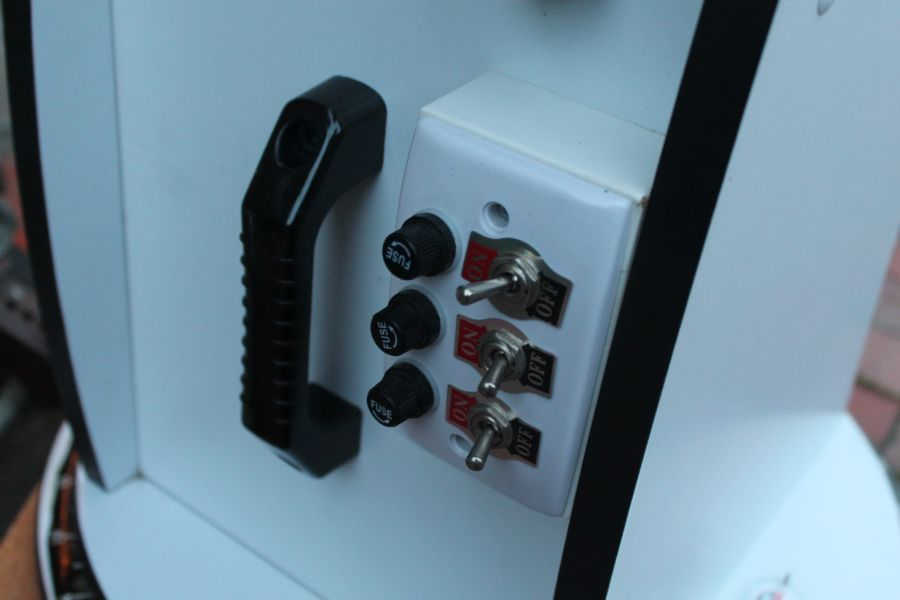
Some nice throw switches with cables leading to a fan.
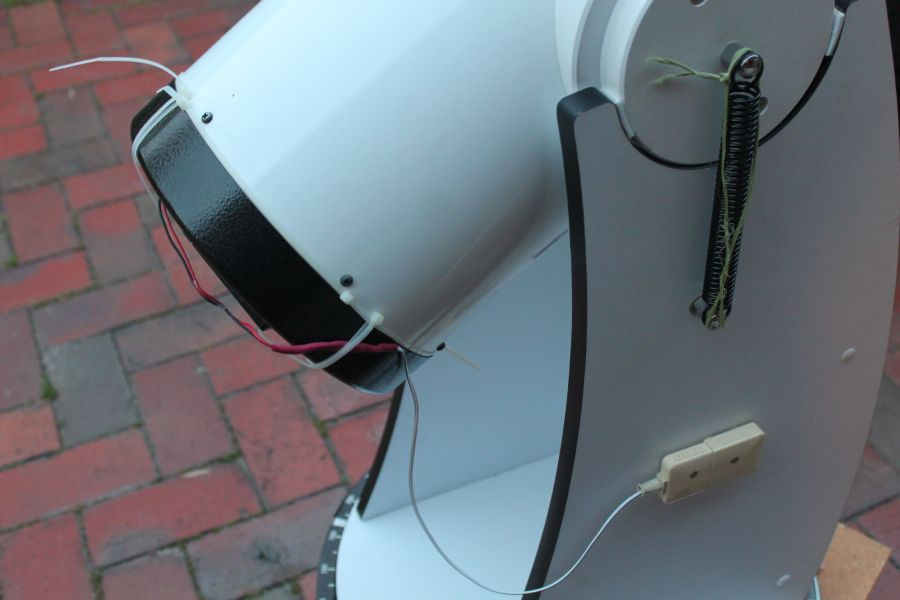
Battery pack cables through phone wire.
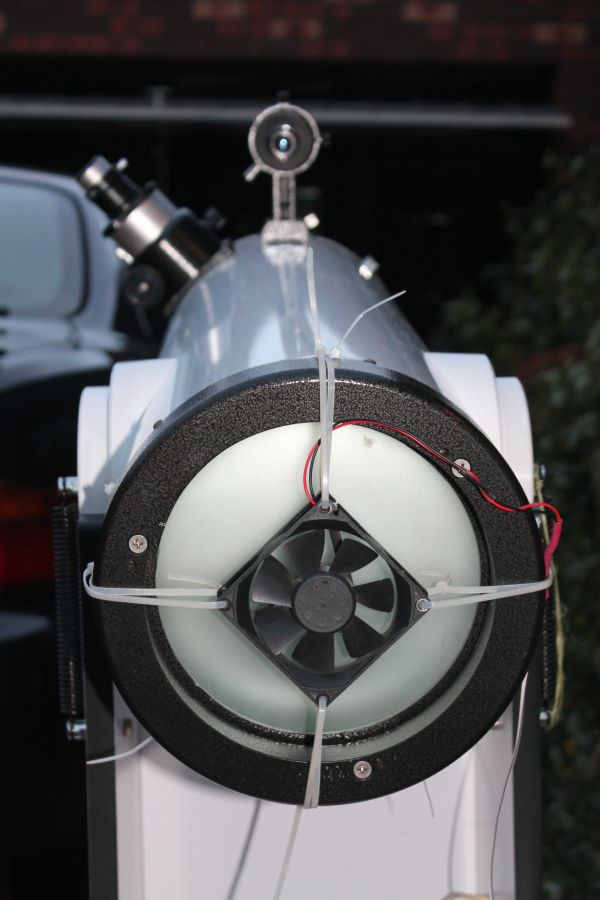
The setup!
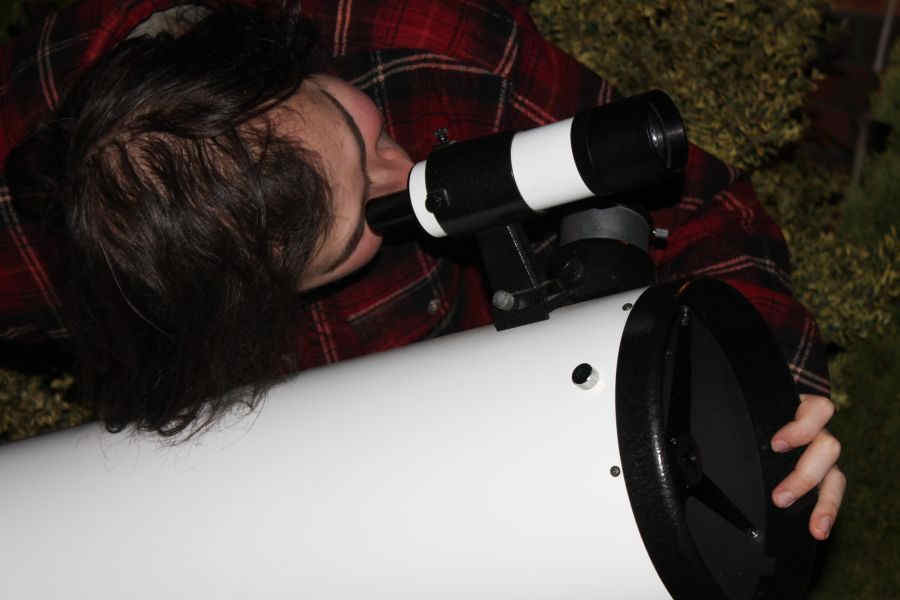
My brother lining it up.
The results: My brother hooked up 4 AA batteries. They run out fast so need to be disconnected when not in use. If I leave them in and flick the switch after a month or three the fan spins for a few seconds and then stops.
This setup is really awesome. If another one of those once-in-60k year things like the Mars opposition of 2003 pop up again, people need all the help they can get in getting the best view! I've had this scope for ten years now. It's a cheap but good setup. Lots of amateurs have way better equipment but you don't need it.
UPDATE: May 2015. I have just ordered collimation knobs as well as a Celestron 2X Barlow to begin messing around with planetary astrophotography.
UPDATE: We finally got these fitted. So, we accidentally ordered the wrong ones but Bob from Bob's knobs was very very kind enough to put this right, sending us extra knobs at no extra charge! OMG! He gave us instructions on how to fit them! AWESOME! A 2003 telescope is now approximating a 2015 telescope (Except for the old-school rack and pinion focuser! Next mod?) Check out his page: Bob's Knob's Link
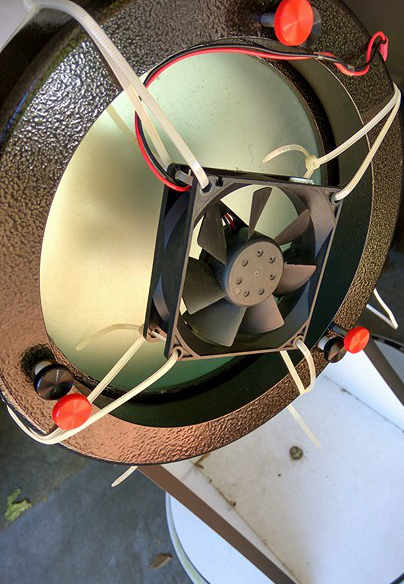
Cheers Guys! Me at the scope in 2015! Wooohoooo! Photographing an eclipse!

UPDATE: 2019, Have finally purchased a laser collimator. I have found this is absolutely essential and the scope is now better collimated than ever! Such a good idea! Wooohooo!
Powered by FolderCMS





